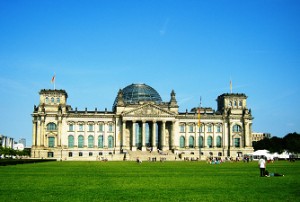
The second weekend of July marked the official beginning of ECLA’s International Summer University. It was a weekend abounding in novelties with new students trying to get to know each other and going on two trips to kick-start the international summer university on Prussia: Philosophy, Rebellion and the State. What follows is an account of these two excursions.
In accordance with the topic of this year’s ISU, the trips covered the period of German history from modernity back to the era of King Frederick the Great, Prussia’s main proponent of enlightenment. You might as well have guessed, but it is still my duty to unravel the mystery and candidly state that we visited the Reichstag and Sanssouci, King Frederick the Great’s summer residence in Potsdam.
The seat of the German Bundestag, the Reichstag, was built in 1894 and again reconstructed in 1999 by the British architect Norman Foster. It is an imposing building which stands witness to Germany’s “long and winding road” towards democracy.
Starting in the main hall leading to the plenary chamber, our guided tour passed through several galleries featuring art works of different artists, then we went on to see the largely perplexing and open-to-interpretations chapel in the Reichstag, along with the drawers of all democratically elected MPs (even Hitler’s). Passing by the walls inscribed with graffiti of Russian soldiers, we finally arrived to the plenary chamber to listen to a short but insightful lecture into German Parliamentary democracy.
Finally, we went up to the upper part of the Reichstag and climbed up the stairs of the glass dome, the symbol of transparency and openness. The “Dem Deutschen Volke” inscription simply confirms that the Reichstag deserved the title of “the heart of German democracy”.
The following day, we made a leap in time and a change of track, and went to visit Sanssouci, the summer palace of King Frederick the Great. Located in Potsdam, the state capital of Brandenburg, Sanssouci was built between 1745 and 1747 in rococo style. Often times called the German Versailles, this palace is smaller in dimension than Versailles but much livelier in spirit.
As you walk from the Entrance Hall through the Marble Hall and the King’s different rooms—dining room, study room, and a small yet well-preserved library, enlightenment seems to speak to you from the paintings and wallpapers, and the statues and instruments in all of these rooms.
Finally, we went outside to get lost in the endless green of the gardens and to truly experience the carefree spirit of this palace. Indeed, this palace of modest dimensions still carries a grand significance in itself, for walking through and around it, one can truly feel the refinement and splendor that was left behind by the Prussian Frederick the Great.
As the weekend drew to a close, all of us felt exhausted and awestruck in equal measure by the grandiosity of the two buildings. Not only do they hold a remarkable appeal for the ordinary tourist, but they also bear a great historical significance, which is of special interest for all ECLA students.
Personally, I was impressed with the idea of walking down the same corridors and galleries that were once inhabited by historically crucial figures in Germany. The heroes of history books descended into the real world and historical events unfolded one by one in our mind’s eye.
It was probably that weekend that we truly understood that we have embarked on exploring a challenging, yet enjoyable topic, and we are looking forward to being “enlightened”.
by Gjurgica Ilieva (ISU’11, Macedonia)
